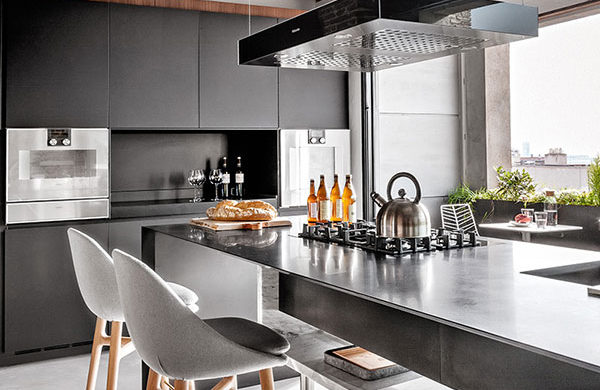
I was in a period house recently where the layout was virtually untouched. In stark contrast to the beautifully adorned entrance hall and reception rooms was the tiny kitchen located at the end of a small corridor. The room was modestly fitted out with the bare minimum of cupboards and one window onto the side passage. The room felt more like an afterthought than the heart of the home.
How things have changed. Today’s kitchens are the centrepiece of the home. They are multifunctional spaces where aside from cooking and dining, we live, entertain and relax. So it’s really important you spend time getting the practicalities right early in the design process. One such practicality is your choice and location of extractor fan.
There are two main types of extractors, ducted and recirculation models. Of the two methods ducted extractors are the most effective at removing steam and odours. They work by passing air through ducting and venting it to the outside.
For ducted extractors to work they need to be located so the ducting can easily access an exterior wall. It’s advisable to use the largest diameter ducting you can to allow the greatest volume of air to be removed. The maximum length a duct can be is five meters. When planning the location of your hob you need to figure out the most direct route for the ducting to run. In other words avoid bends in the ducting because it will limit the extractor’s effectiveness.
If your hob is too far away from an outside wall you will have to opt for a recirculation extractor. These are fairly common in apartments or houses where the kitchen is centrally located and not near any exterior walls. These extractors take the air and pass it first through a grease filter and then through a charcoal filter where it is purified, after which it is recirculated back into the kitchen. Unwanted elements are left behind in the charcoal so filters need to be replaced periodically. Although these aren’t as effective as the ducted type they do have advantages. You can locate your hob wherever you like and because they don’t require any ducting they’re relatively easy to install and so are often less expensive.
Most cooker hoods can be installed to work with recirculation or ducted systems. Some models are only suitable for a ducted system so it’s important to check the specification of the model you like and check with the supplier to make sure it will work with your proposed kitchen layout.
The location of your hob will have a huge bearing on the style of extractor you choose. The more traditional wall mounted, canopy or integrated styles of extractor are ideal if you hob is located against a wall. But if your hob is located on an island in an open plan space you might wish to select a more unobtrusive style of extractor.
There are a number of options available; the first is a ceiling-mounted model, which can be built into the ceiling – meaning there is no obstruction to the line of sight and ideal in an open-plan space. Another alternative is a downdraft extractor which is built into the work surface. It rises up out of the worktop when in use, but sits completely flush with the surface when not. There are induction and electric hobs with built in downdraft extraction where the extractor looks like an additional ring in the centre of the hob.
Alternatively, in an open plan setting you may wish to make a feature of the extractor and opt for a decorative pendant extractor which often resemble light fittings and are suspended from the ceiling over the hob. Many of these suspended fittings are suitable for recirculation only, so take advice whether this will be enough for your kitchen’s needs.
Noise is often a consideration when choosing an extractor, typically the faster the speed setting the noisier the unit will be. The more expensive models however tend to be quieter.